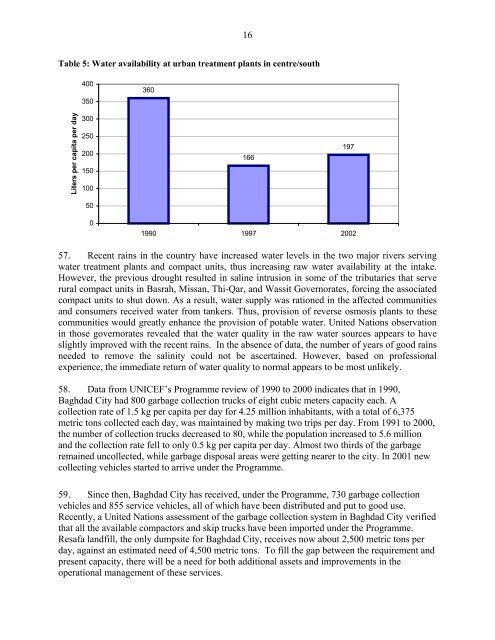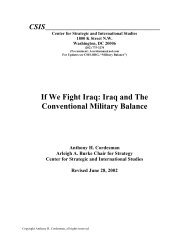16Table 5: Water availability at urban treatment plants in centre/south400350360Liters per capita per day3002502001501001661975001990 1997 200257. Recent rains in the country have increased water levels in the two major rivers servingwater treatment plants and compact units, thus increasing raw water availability at the intake.However, the previous drought resulted in saline intrusion in some of the tributaries that serverural compact units in Basrah, Missan, Thi-Qar, and Wassit Governorates, forcing the associatedcompact units to shut down. As a result, water supply was rationed in the affected communitiesand consumers received water from tankers. Thus, provision of reverse osmosis plants to thesecommunities would greatly enhance the provision of potable water. United Nations observationin those governorates revealed that the water quality in the raw water sources appears to haveslightly improved with the recent rains. In the absence of data, the number of years of good rainsneeded to remove the salinity could not be ascertained. However, based on professionalexperience, the immediate return of water quality to normal appears to be most unlikely.58. Data from UNICEF’s Programme review of 1990 to 2000 indicates that in 1990,Baghdad City had 800 garbage collection trucks of eight cubic meters capacity each. Acollection rate of 1.5 kg per capita per day for 4.25 million inhabitants, with a total of 6,375metric tons collected each day, was maintained by making two trips per day. From 1991 to 2000,the number of collection trucks decreased to 80, while the population increased to 5.6 millionand the collection rate fell to only 0.5 kg per capita per day. Almost two thirds of the garbageremained uncollected, while garbage disposal areas were getting nearer to the city. In 2001 newcollecting vehicles started to arrive under the Programme.59. Since then, Baghdad City has received, under the Programme, 730 garbage collectionvehicles and 855 service vehicles, all of which have been distributed and put to good use.Recently, a United Nations assessment of the garbage collection system in Baghdad City verifiedthat all the available compactors and skip trucks have been imported under the Programme.Resafa landfill, the only dumpsite for Baghdad City, receives now about 2,500 metric tons perday, against an estimated need of 4,500 metric tons. To fill the gap between the requirement andpresent capacity, there will be a need for both additional assets and improvements in theoperational management of these services.
17The three northern governorates60. Access to potable water is still much below the standard adequacy line, both in terms ofquantity and quality. The estimated per capita availability varies from about 100 litres in semiurbanareas to approximately 150 litres in the main cities of Dahuk, Erbil and Sulaymaniyah.Only 60 per cent of treated water reaches final consumers because of deterioration of thedistribution networks. High leakage and excessive wastage of water among urban householdsdue to the absence of water-meters are increasing shortages in all three northern governorates.Results from a survey on water supply and sanitation services conducted by UNICEF in urbanand semi-urban areas of Sulaymaniyah in 2001, showed that the existing networks benefited lessthan 60 per cent of the population. The survey comprised an assessment of water supply in bothurban and semi-urban areas of Sulaymaniyah Governorate. As a result, 40 per cent of householdscontinue to rely on water extracted from shallow wells or on supplies from tankers.61. Quality and quantity of water supplied to households in rural areas are well belowstandards. Estimated per capita supply is in the range of 20 to 30 litres as opposed to theminimum standard: 50 litres per capita per day, with a contamination level of less than fiveEcoli per 100 ml per sample. At times up to 50 per cent of the samples analyzed presentcontamination levels above the standard. Most rural water supply facilities, such as standpipes,were rapidly constructed as an emergency response before the start of the implementation of theProgramme, with undue provision of future expansion and sometimes with poor quality ofconstruction resulting in the need for rehabilitation.62. During the reporting period, the United Nations collected drinking water samples forbacteriological and chemical analysis. From a chemical point of view, more than 98 per cent ofthe samples were within WHO guidelines. Almost 100 per cent of water collected in the urbanareas of Dahuk, 78 per cent in Erbil cities, 95 per cent in Sulaymaniyah towns continued tocomply with WHO guidelines regarding bacteriological quality. Yet the quality of water insemi-urban districts, with a mean of 83 per cent, and rural areas, with a mean of 58 per cent, didnot comply with WHO guidelines.63. The UNOPS urban water and sanitation project has established its headquarters in Erbil,with field offices in Dahuk and Sulaymaniyah, staffed by local engineers. To date, however,only one out of six international staff members, the project manager, has been granted a visa,thus delaying the effective implementation of the project.64. Basic city maps are nearly complete showing land, roads and housing on which detailedinformation concerning the location of water sources, water and sewage networks, electricity andtelecommunications networks, population density, major water users and sources of pollutioncan be overlaid. A tender has been issued for this detailed survey. Once completed, the data willprovide, in conjunction with a master plan, a firm basis for planning and programming of inputs.65. A detailed bill of quantities has been drawn up for the replacement of pumps in theSulaymaniyah-Dokan water supply project and the Ifraz and Ainkawa treatment plant in Erbil.A tender has been issued for the construction of a machine shop in Erbil that will repair
















